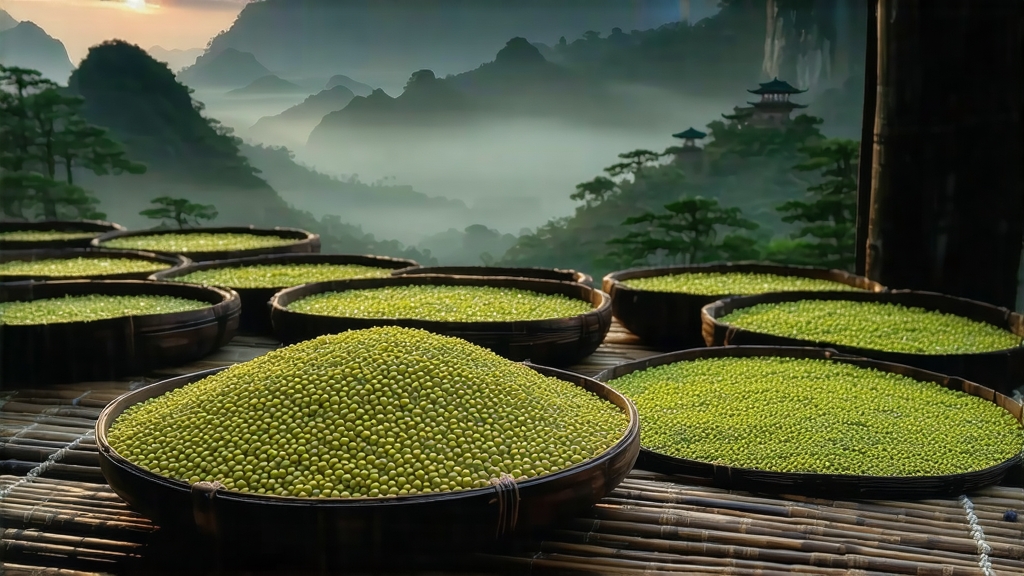
Tucked high above the Sichuan basin, where perpetual cloud veils the Min River gorge, lies Meng Ding Mountain, the cradle of the world’s oldest cultivated tea garden. It was here, in the mist-cooled terraces of Ganlu Temple, that Buddhist monks first coaxed the subtle golden liquor now known as Meng Ding Huang Ya—“the yellow bud from Meng Ding.” For thirteen centuries this leaf was carried in silk-lined chests to the emperors of Tang, Song, Ming and Qing, yet outside China it remains almost mythic, eclipsed by green and black cousins. This essay invites the global tea traveler to rediscover Meng Ding Huang Ya: its birth among cliffside temples, the micro-terroir that paints its flavor, the labor-intensive “sealed yellowing” that sets it apart, and the quiet ritual that releases its orchid-and-chestnut soul.
-
Historical echoes
The first written record appears in the Tang dynasty compendium Meng Ding Tea Notes (AD 813), praising “a bud of pale jade, turning golden in the cup, bestowed upon the Son of Heaven.” During the Song, the mountain’s abbot stipulated that picking could begin only when the morning bell rang, ensuring dew still cloaked the leaf. By the Ming, imperial magistrates sealed the passes each spring; any commoner caught smuggling the harvest faced flogging. The Qing added a poetic flourish, ranking Meng Ding Huang Ya among the “Six Rare Tributes” alongside pearls from the South China Sea. When the last emperor abdicated in 1912, the tribute system collapsed; gardens reverted to monks and villagers, and the tea slipped into domestic obscurity. Only since the 1980s has a small band of artisans revived the original yellowing craft, exporting limited lots to Europe and North America. -
Terroir and cultivar
Meng Ding rises to 1,456 m, brushing the Sichuan cloud base 280 days a year. Diurnal swings of 10 °C slow leaf growth, stacking amino acids—especially L-theanine—until the bud weighs almost twice that of a lowland leaf. The soil is a friable purple sandstone rich in selenium and zinc, drained by mountain springs that once filled the monks’ stone cisterns. The traditional cultivar is the local “Ganlu #1,” a sinensis-var. sinensis landrace with petite buds whose downy reverse side catches the light like frost. A newer clonal selection, “Meng Huang #3,” ripens three days earlier and tolerates higher oxidation during yellowing, but purists insist only the old strain delivers the signature “orchid finish.” -
Plucking etiquette
The picking window opens between Qingming and Grain Rain (early to mid-April) when nights still dip to 8 °C. Two standards govern the harvest: “Bud-only” (jin ya) for the top grade, and “one bud with an infant leaf” (xiao kai mian) for the second. Experienced pickers pinch the stem with the nail of the middle finger to avoid body heat; buds drop into bamboo baskets lined with fresh fern fronds that keep humidity at 75 %. A full day’s yield per worker is barely 500 g fresh weight, translating into 100 g finished tea. -
The sealed-yellowing craft
What converts an otherwise green tea into yellow is a post-kill-green “men huang,” literally “sealed yellowing.” The process is equal parts biochemistry and meditation:
Step 1: Sha Qing (kill-green)
Leaves are tumble-fired in bamboo drums at 160 °C for 90 seconds to deactivate polyphenol oxidase. The goal is preservation of green character, yet the short roast leaves residual moisture around 60 %.
Step 2: Re Tuan (hot rolling)
Immediately after firing, the scorching leaves are rolled into tight spirals under 8 kg of pressure. This ruptures 30 % of cell walls, releasing sticky amino acids that will later act as reducing agents.
Step 3: Men Huang (sealed yellowing)
The critical deviation from green-tea protocol. Rolls are wrapped in steamed mulberry paper, then packed into square cedar boxes lined with wet cotton. Boxes rest in a dark cellar at 28 °C and 85 % humidity for 48–72 hours. During this sauna-like confinement, chlorophyll degrades to pheophytin, catechins dimerize into theaflav